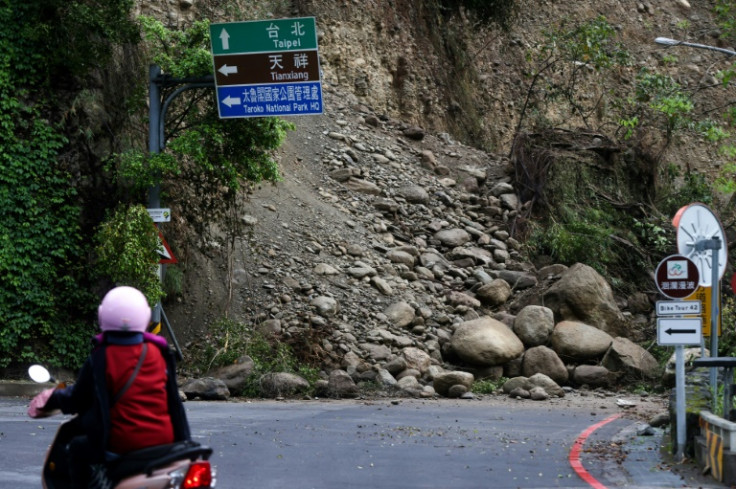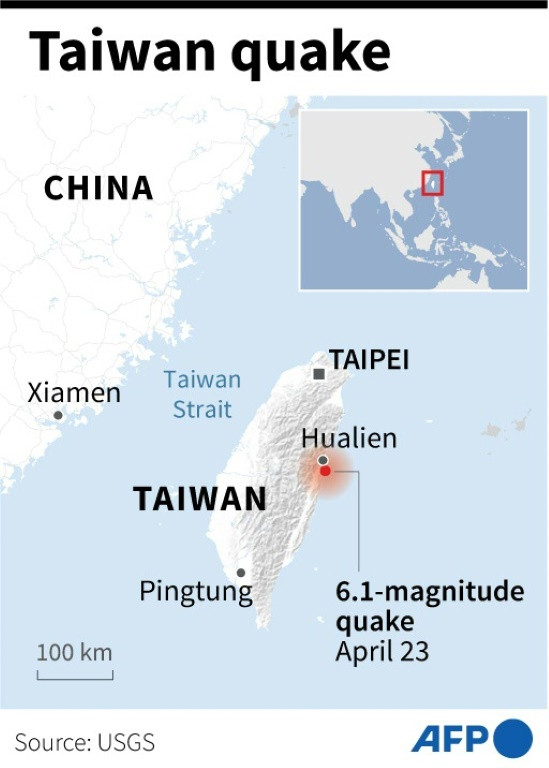Taiwan Hit By Dozens Of Strong Aftershocks From Deadly Quake

Taiwan was shaken by dozens of earthquakes overnight and into Tuesday that left buildings swaying and some tilting, with the government saying they were aftershocks from a huge deadly quake that hit the island more than two weeks ago.
The strongest, which the US Geological Survey measured at magnitude 6.1, hit around 2:30 am (1830 GMT) followed minutes later by a 6.0 tremor.
Taipei's Central Weather Administration put them at 6.0 and 6.3, respectively.
Authorities said there were no casualties reported so far, but the non-stop shaking meant a restless night even for those in the capital Taipei about 150 kilometres (90 miles) north, where walls and glass panels rattled in swaying homes.
"I was too scared to move and stayed in bed," said office worker Kevin Lin, 53, in Taipei, who told AFP he was jolted awake by the intense quakes.
Around 8:00 am, a 5.8-magnitude tremor shook the capital as commuters made their way to work.
The tremors started Monday around 5:00 pm and by about 10:30 am the next day the Central Weather Administration said it had recorded more than 200 quakes.
All had originated from Hualien on the central east coast of Taiwan.
The mountainous county was the epicentre of a magnitude-7.4 quake that hit April 3, which Taiwan said was the "strongest in 25 years", triggering landslides that blocked roads and severely damaged buildings around the main Hualien city.
At least 17 people were killed, with the latest body found in a quarry on April 13.
A hotel building in Hualien that was previously damaged started tilting at an angle on Tuesday after the quakes, according to footage obtained by AFP.
"Please come out for your safety. Let's evacuate first OK? Anyone still inside? Please come down," shouted a firefighter to the residents of nearby buildings.
Hsu-ho Lin told local news channel Formosa TV that he had immediately ran over to the hotel building because his grandma lives there and she "kept refusing to leave".
"My grandmother insisted on staying and my grandfather could not persuade her," Lin said, adding that they were now evacuating from the building.
The first floor of a nearby residential building was flattened by Tuesday's quakes, its tilting frame precariously propped up by metal beams.
Tenants had already evacuated from there after the April 3 quake, and the building was awaiting demolition.
Hualien county government announced that schools and offices would be closed Tuesday due to the continuous aftershocks.
Taiwan sees frequent earthquakes due to its location at the junction of two tectonic plates, and the April 3 quake was followed by more than 1,100 aftershocks -- causing rockfalls and tremors around Hualien.
A Taipei government seismologist said the latest "swarm" of tremors originated to the south of the main April quake, unlike the earlier ones which had been mainly to the north.
Seismologists Judith Hubbard and Kyle Bradley agreed the activity appeared to have shifted to becoming more concentrated on the southern side of the April 3 rupture.
"The new cluster of seismicity is not a typical mainshock-aftershock sequence," they wrote in their newsletter "Earthquake Insights".
The recent quakes appeared to have stepped up in magnitude over time, they said -- counter to the usual pattern of a large one that gradually decays.
It remains unclear if this could trigger a large earthquake again, but "this swarm is a certainly good opportunity for people in the region to revisit their recently tested earthquake preparations", they said.
The April 3 tremor was the most serious in Taiwan since 1999, when a magnitude-7.6 quake hit the island. The death toll then was far higher, with 2,400 people killed in the deadliest natural disaster in the island's history.
Stricter building regulations -- including enhanced seismic requirements in its building codes -- and widespread public disaster awareness had staved off a more serious catastrophe in the April 3 quake.
In Taipei, Lin said news of the hotel tilting in Hualien had scared him.
"I live in a 40-year-old apartment and it really worries me whether the apartment can withstand so many earthquakes," he told AFP.
He added that while the Taiwanese public are taught what to do when a tremor hits, "it is only useful for a small quake".
"For a big one, it doesn't really matter how much quake response you're taught."


© Copyright AFP 2025. All rights reserved.





















